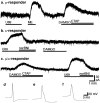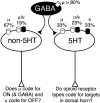Rostral ventromedial medulla neurons that project to the spinal cord express multiple opioid receptor phenotypes
- PMID: 12486178
- PMCID: PMC6758433
- DOI: 10.1523/JNEUROSCI.22-24-10847.2002
Rostral ventromedial medulla neurons that project to the spinal cord express multiple opioid receptor phenotypes
Abstract
The rostral ventromedial medulla (RVM) forms part of a descending pathway that modulates nociceptive neurotransmission at the level of the spinal cord dorsal horn. However, the involvement of descending RVM systems in opioid analgesia are a matter of some debate. In the present study, patch-clamp recordings of RVM neurons were made from rats that had received retrograde tracer injections into the spinal cord. More than 90% of identified spinally projecting RVM neurons responded to opioid agonists. Of these neurons, 53% responded only to the mu-opioid agonist D-Ala2, N-Me-Phe4, Gly-ol5 enkephalin, 14% responded only to the kappa-opioid agonist U-69593, and another group responded to both mu and kappa opioids (23%). In unidentified RVM neurons, a larger proportion of neurons responded only to mu opioids (75%), with smaller proportions of kappa- (4%) and mu/kappa-opioid (13%) responders. These RVM slices were then immunostained for tryptophan hydroxylase (TPH), a marker of serotonergic neurons. Forty-percent of spinally projecting neurons and 11% of unidentified neurons were TPH positive. Of the TPH-positive spinally projecting neurons, there were similar proportions of mu- (33%), kappa- (25%), and mu/kappa-opioid (33%) responders. Most of the TPH-negative spinally projecting neurons were mu-opioid responders (67%). These findings indicate that functional opioid receptor subtypes exist on spinally projecting serotonergic and nonserotonergic RVM neurons. The proportions of mu- and kappa-opioid receptors expressed differ between serotonergic and nonserotonergic neurons and between retrogradely labeled and unlabeled RVM neurons. We conclude that important roles exist for both serotonergic and nonserotonergic RVM neurons in the mediation of opioid effects.
Figures








Similar articles
-
Activation of mu-opioid receptors inhibits synaptic inputs to spinally projecting rostral ventromedial medulla neurons.J Pharmacol Exp Ther. 2004 May;309(2):476-83. doi: 10.1124/jpet.103.064808. Epub 2004 Jan 14. J Pharmacol Exp Ther. 2004. PMID: 14724227
-
Opioid receptor modulation of GABAergic and serotonergic spinally projecting neurons of the rostral ventromedial medulla in mice.J Neurophysiol. 2011 Aug;106(2):731-40. doi: 10.1152/jn.01062.2010. Epub 2011 May 18. J Neurophysiol. 2011. PMID: 21593395
-
Electrophysiological heterogeneity of spinally projecting serotonergic and nonserotonergic neurons in the rostral ventromedial medulla.J Neurophysiol. 2006 Mar;95(3):1853-63. doi: 10.1152/jn.00883.2005. Epub 2005 Dec 7. J Neurophysiol. 2006. PMID: 16338998
-
Endogenous opioid peptides in the descending pain modulatory circuit.Neuropharmacology. 2020 Aug 15;173:108131. doi: 10.1016/j.neuropharm.2020.108131. Epub 2020 May 15. Neuropharmacology. 2020. PMID: 32422213 Free PMC article. Review.
-
Opiate receptor multiplicity: evidence for multiple mu receptors.Monogr Neural Sci. 1987;13:121-31. doi: 10.1159/000414573. Monogr Neural Sci. 1987. PMID: 2825002 Review. No abstract available.
Cited by
-
Brainstem facilitations and descending serotonergic controls contribute to visceral nociception but not pregabalin analgesia in rats.Neurosci Lett. 2012 Jun 21;519(1):31-6. doi: 10.1016/j.neulet.2012.05.009. Epub 2012 May 9. Neurosci Lett. 2012. PMID: 22579856 Free PMC article.
-
Wound Repair and Extremely Low Frequency-Electromagnetic Field: Insight from In Vitro Study and Potential Clinical Application.Int J Mol Sci. 2021 May 10;22(9):5037. doi: 10.3390/ijms22095037. Int J Mol Sci. 2021. PMID: 34068809 Free PMC article. Review.
-
Involvement of Parvalbumin-Positive Neurons in the Development of Hyperalgesia in a Mouse Model of Fibromyalgia.Front Pain Res (Lausanne). 2021 Feb 26;2:627860. doi: 10.3389/fpain.2021.627860. eCollection 2021. Front Pain Res (Lausanne). 2021. PMID: 35295447 Free PMC article.
-
cAMP-mediated mechanisms for pain sensitization during opioid withdrawal.J Neurosci. 2005 Apr 13;25(15):3824-32. doi: 10.1523/JNEUROSCI.5010-04.2005. J Neurosci. 2005. PMID: 15829634 Free PMC article.
-
Kappa-opioid agonists directly inhibit midbrain dopaminergic neurons.J Neurosci. 2003 Nov 5;23(31):9981-6. doi: 10.1523/JNEUROSCI.23-31-09981.2003. J Neurosci. 2003. PMID: 14602811 Free PMC article.
References
-
- Ackley MA, Hurley RW, Virnich DE, Hammond DL. A cellular mechanism for the antinociceptive effect of a kappa opioid receptor agonist. Pain. 2001;91:377–388. - PubMed
-
- Azami J, Llewelyn MB, Roberts MH. The contribution of nucleus reticularis paragigantocellularis and nucleus raphe magnus to the analgesia produced by systemically administered morphine, investigated with the microinjection technique. Pain. 1982;12:229–246. - PubMed
-
- Bederson JB, Fields HL, Barbaro NM. Hyperalgesia during naloxone-precipitated withdrawal from morphine is associated with increased on-cell activity in the rostral ventromedial medulla. Somatosens Mot Res. 1990;7:185–203. - PubMed
-
- Christie MJ. Do medullary serotonergic neurons tonically modulate nociceptive transmission. Pain Forum. 1998;7:155–158.
Publication types
MeSH terms
Substances
Grants and funding
LinkOut - more resources
Full Text Sources
Other Literature Sources
Research Materials
